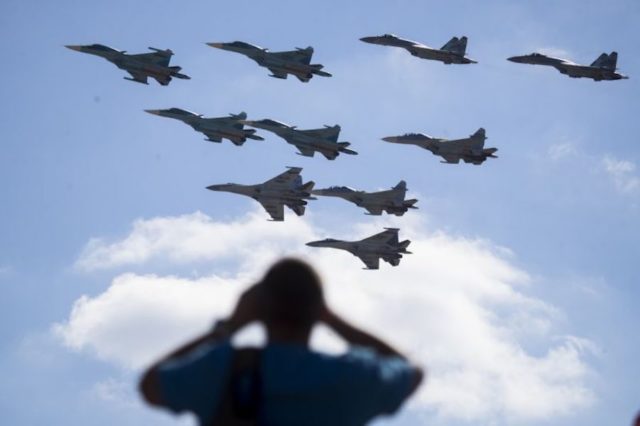Editor’s Note: The JPC on occasion is able to bring readers the views of experts in the field on a variety of foreign and domestic issues. Hurricane Harvey, North Korea and Iran have pushed the upcoming “Zapad” exercise conducted by Russia down the news cycle, but it has implications for the United States and NATO. We are pleased to publish the work of Bruce Jones, a security policy adviser who has lived and worked in Russia and the former Soviet Union.
Moscow’s strategic level “Zapad-2017” exercise, being held in the Baltic region on September 14-20, has been occupying the attention of western governments and Russia watchers since the beginning of the year. The concerns surround not only the yet-to-be-determined numbers of troops involved, but also the crucial area in which the maneuvers take place. Some analysts fear that the exercise is a cover for Russia to occupy Belarus or to take control of parts of Poland and the Baltic states and separate them from the rest of Europe.
The United States and others have accused Moscow of leveraging the exercise build-up, magnified by the lack of Russian transparency surrounding it, as a means to “destabilize” security throughout the entire region. At the same time the focus towards Zapad is drawing attention, and limited western analytical resources, away from potential developments involving Russia elsewhere, in Ukraine, Moldova, the eastern Balkans and the Far North.
Zapad, meaning “West,” is the continuation of the Soviet exercises of the same name, practicing the theater-level invasion of Western Europe.
The joint Russian and Belarus drills with land, naval, air, airborne and amphibious forces are held every two years in north-western Russia, its Baltic exclave of Kaliningrad between Poland and Lithuania, in Belarus, and in the Baltic Sea: geographically encircling the Baltic states and bordering on Poland.
Zapad was last staged in 2013, because hostilities in Ukraine intervened in 2015.
Preparations
In what has become a template for Russian capabilities, Moscow in July 2013 carried out a snap inspection exercise, mobilizing some 160,000 troops, transporting them across seven time zones and deploying them in the country’s Far East in only a handful of days. Some past Zapad exercises have included more than 100,000 troops and the firing of SS-21 Tochka-U tactical ballistic missiles in the Kaliningrad territory, which some western analysts contend depicted a nuclear strike on Poland finalizing operations.
The concern has always been that one day this might be the “real thing.”
The most vulnerable point in the region is the 40-mile wide Suwalki Gap separating Kaliningrad from Belarus, and potentially the Baltic states from the rest of NATO and the EU, and any NATO reinforcements intended for the region.
Russia is expected to field the 20th Combined Arms Army and 1st Guards Tank Army, which have both recently been supplemented with newly created divisions, plus the Belarus armed forces, and forces from the now heavily militarized and “invested” Kaliningrad territory. Selected and ready to participate are the massive 76th Air Mobile Division Group based at Pskov, on the Estonian border, and other airborne and “Spetnaz” units which have recently been involved in Georgia, the Ukraine and Crimea.
As a fresh move this year, 50 vessels of Russia’s Northern Fleet based on the White Sea and Kola Peninsula have been prepared to take part. Whether this indicates envisioned exercise activity in areas adjacent to Scandinavia is unknown. A further 70 vessels are already prepared in the Baltic Fleet.
The numbers of forces and vessels involved amount to more that almost any other country could put together.
War of Nerves
Unlike other recent exercises, information about Zapad has been intermittent, if not taunting. The first reference was the disclosure in November 2016 of 4,162 specially chartered rail cars for the exercise, normally used for transporting mobilized reservists – in this case as many as 50,000 to Belarus.
This was followed, between information voids, by intimations that the exercise might be used by Russia to change the regime and occupy Belarus, which in addition to other concerns, would bring Russia’s borders and its offensive and defensive “missile dome” a worrying 500 miles further west.
In contrast to Zapad, Russia’s previous major exercise, Kavkaz-2016 (Caucasus) last September, was widely ‘publicized’ for a year beforehand.
Numbers Games
As early as May this year U.S. defense secretary James Mattis accused Russia’s upcoming exercise build-up of being “destabilizing.” Moscow, however, rejected the claims that the nature, scale, and secrecy surrounding Zapad would upset regional security.
On the ground, Lithuanian intelligence and others believe that Russian and Belarus’ troop numbers may exceed 100,000, accompanied by incidents on the Lithuanian and Polish borders. The Russian and Belarus governments have however stuck to the line that no more than 13,000 personnel will take part.
On September 1, the commander of the US Army in Europe (USAREUR) LTG Ben Hodges called on Russia to allow outside media to observe the drills, noting that while Russian inspectors attended NATO exercises all the time, Moscow had given little reason to trust the numbers that it had provided.
Moscow suspended its adherence to the Conventional Forces in Europe (CFE) Treaty indefinitely in 2007. Regional hotlines designed to avoid escalation and misunderstandings with Moscow have since been dismantled, and matters are further aggravated by Moscow’s non-compliance with existing arms control agreements, for example, the Intermediate-Range Nuclear Forces’ (INF Treaty). Notification 42 days in advance, is though required under the 2011 Vienna Document of the Organization for Security and Co-operation in Europe (OSCE) of maneuvers involving more than 13,000 troops.
At the end of Kavkaz-2016, Russia’s chief of the general staff, General Valery Vasilyevich Gerasimov, announced that the total number of troops involved had in fact been 120,000 rather than the 12,000 advertised, which he explained away casually with legalistic arguments, that no agreements had been broken, not all the troops were present concurrently, they were from different formations, and some were civilians.
On 25 August NATO Secretary General Jens Stoltenberg announced that he believes he has adequate support to revamp OSCE’s cornerstone Vienna Document, to ensure that unannounced exercises can be subjected to “snap monitoring,” and that small, multiple maneuvers nominally under different commands, can be recognized as a single exercise, which he said are loopholes Moscow is exploiting. Agreement though is likely to take many years.
Inviting Controversy
In late July, conforming to the OSCE’s stipulated 42 days’ notice, Belarus issued invitations to observe the maneuvers to defense attachés accredited to Minsk and more widely to international arms control personnel. Different nations were invited to attend various stages of the exercise, with them all meeting together on September 20, the final day.
Whether indicating a disjoint between Moscow and Minsk or not, in mid-August, in less than the OSCE’s stipulated 42 days, Russia followed suit, by inviting only Moscow-accredited military attachés to the exercise on September 18–19 at the Luga artillery and missile range, 100 miles east of Estonia and south of St Petersburg. The invitations were not all issued at the same time and whether by act or omission, in what seemed to be a deliberate and effective attempt at “divide and rule,” some countries had been invited, while others had not.
Adding to the rising temperature surrounding the drills, some senior figures complained publicly that their countries had been left out. In the end though, everyone who thought they should have an invitation appeared to have received one.
The “Threat”
Russia and Vladimir Putin, more than anyone, understand the meaning of the “threat” – the possession of military force and deterrence and how it can be leveraged in order to achieve and secure international political effects. It is not a question of quotas, equivalence or parities, but of holding large numbers of nuclear and conventional weapons, not all necessarily treaty compliant, and using their presence and existence as leverage against intended targets.
In eastern Ukraine, it translated as the creation of an umbrella under which to carry out unchallenged hybrid and unconventional warfare.
In NE Europe the superiority in Russia’s strength of arms has been translated in the approach of exercise Zapad.
War on the Mind
Whereas previous exercises in the series have been to ensure that the troops perform their tasks correctly, in this case that seems to be a somewhat secondary aim.
Using the prospect of the exercise, the Kremlin’s actions for the last year have included over-flights, border issues, intelligence incidents, fake news, info war, cyber events, bogus diplomacy, attempts at divide and rule, spurious official announcements, ‘peace camps’ in neutral Sweden and Finland and … so forth. This has all been multiplied further by Moscow’s lack of cooperation and absence of transparency.
Russia has sought to compress and degrade others’ leadership and decision-making processes and to induce division, compliance, complacency and reflexive control.
The overarching objectives in the exercise build-up have been to test, gauge, weaken and exploit NATO and Scandinavian military and governmental resources and cohesion, along with the parallel goals of increasing local public uncertainty and political strain.
It equates to previously un-witnessed, strategic-level “aktivnyye meropriyatiye – active measures,” in which a series of covert actions, subterfuge, incidents, disinformation and far-fetched fabrications are used to convert a country or entity, in this instance groups of countries, from one political status and set of circumstances to another.
It has compelled leading figures from Defense Secretary Mattis downward, including LTG Hodges, and heads of state and of government and senior ministers to “dance to Moscow’s tune” by forcing them – however prudently – to set out their own default positions, or highlight or respond to the developing situation instigated solely by Russia.
Do You Feel Lucky?
Were the drills all but scrapped, one could arguably conclude that they would have largely served their purpose in pushing NATO, the Baltic states and Scandinavian countries into a more strategically dependent and compliant, less sanguine and less confident position than they had been a year earlier. But is the West in addition presenting too inviting a target for Vladimir Putin to be able to resist?
The forces we are offering through NATO’s eastern “enhanced Forward Presence” (eFP) and some other small numbers of additional troops are as much as we can muster politically, financially, diplomatically and numerically. Many would argue that even in our own terms they are paltry, if not risible. The situation is exacerbated by “wistful” token commitments that are politically in some cases “hostage to fortune.”
To “break” the West, Putin needs to and can only do so militarily, whether kinetically or by making the West militarily in some way step back. With increasing sanctions, a falling energy-dollar and upcoming unaffordable ambitious defense programs, frighteningly this might be his best and last chance. The Russian military has only ever acted on what it believes are near certainties.
Putin has a Stalin-like grip on the country. When he mysteriously disappeared for 11 days in March 2015 the Kremlin and all state decision-making ground to a halt, for fear of making the wrong call. Few among his acolytes would therefore gainsay or deter him.
Some of his “Siloviki” (former senior intelligence, defense and interior ministry) coterie might encourage him to make the move, because it might be in their interests to do so, but not necessarily in his.
The most favorable hoped for outcome is that the exercise goes ahead, albeit with excessive numbers but few incidents, which Russia legalistically explains away by saying that each of the armies and national forces conducted separate exercises which individually never properly exceeded the given ceilings.






